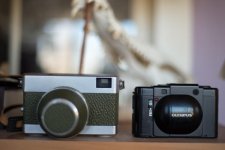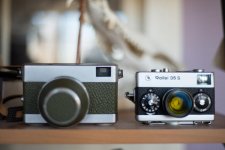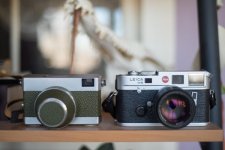PerfesserKev
Newbie
“[FONT=Optima-Regular, sans-serif]I can't believe I've never seen one of these…” I thought when I spied it on that auction site — a minimalist little camera with virtually no brand marks, no knobs, a cool hood/cover and decorated in olive green: The Werra 1.[/FONT]
[FONT=Optima-Regular, sans-serif]Few of these were imported into the U.S., so I imagine that's why they were so unfamiliar to me. But I immediately fell in love with the mid-century modern design of this camera (could be described as Bauhaus, has been described as “Soviet-brutalist” though I think the designers would take that as a stab in the gut) and bought it.[/FONT]
[FONT=Optima-Regular, sans-serif]While I awaited it I sniffed about the interwebs to find out more on its history, its size, its build quality and usability. Cameras don't sit on my shelves. They all get used.[/FONT]
[FONT=Optima-Regular, sans-serif]I read many reviews proclaiming them as “East German Leicas” and such, praising their build quality and dependability as well as the obviously intriguing design. Now that mine has arrived and been around the block a few times I figured I'd post a review here that answers the questions I had that are otherwise unanswered — particularly for us unfamiliar Americans.[/FONT]
[FONT=Optima-Regular, sans-serif]Design: Yes, it's as cool as it looks if you're talking about the flat-topped olive green models. It's a piece of art. The black ones are marred with a brand logo. The metered ones are marred with a selenium cell window. The late ones are downright ugly and have strayed far from the clean appearance of the originals with ugly stripes and faux fabrics. The ones to admire are the green 1s and 3s for their clean lines and surfaces.[/FONT]
[FONT=Optima-Regular, sans-serif]Dependability: It's endured pretty well over its 60 years and probably has never seen a repairman's spanner. Considering that, I would rate the dependability as pretty good. Mine is the export model, featuring a West German Synchro-Compur shutter and a lens marked with the 1Q logo allegedly of “first quality” (though I have yet to see an image of one without that mark). The distance scale is in feet, meaning this one was aimed for us or the Brits. I chose it because I know what to expect from a Compur and can capably clean, lube and adjust one if needed. At 60 years of age, yes, the slow speeds are a little slow and sticky. But it works. The transport is stiffer than it should be and squeaks from a needed lube. When I get the time and gumption I'll tear it all down (and hopefully get it all back together).[/FONT]
[FONT=Optima-Regular, sans-serif]Build Quality: The build quality is acceptable, but not great. Having used Leica Ms professionally for a quarter century I must say that this is no Leica. Anyone who declares it such has obviously not slung a Leica around his or her neck and trekked into tough situations. I love my cameras but the ones I use professionally are tools, not fetishes. When I get a new body or lens it is highly likely that it is taken out of the box, slung around my neck, and immediately dragged into a desert, into a dust storm or into the arctic. I use them lovingly, but they are used. [/FONT]
[FONT=Optima-Regular, sans-serif]The machine quality of the Werra is clean and professional, but there are gaps and ridges between it's plastic green body parts and the metal ones they would leak dust and moisture like crazy. The materials are light aluminum or alloys on the metal parts, and plastic on the green parts. It's not leather-covered metal. The plastic is better than bakelite, but aging and a touch brittle. Overall it has similar fit and finish to my beloved Rollei 35S, and is probably similar in dependability.[/FONT]
[FONT=Optima-Regular, sans-serif]I also have no problems with light materials. A bag of Leicas will send you crying for the chiropractor rather quickly from the weight. And when a Leica lens is dropped on hard concrete you face several hundred dollars in repair costs. By contrast I've watched as every Nikon prime lens I've bought since the mid-80s can bounce down a sidewalk yet I can pick it up, blow the dust off and resume shooting pictures. Metal bends far easier than the plastics those guys use would break. The Werra's plastic would break on a hard drop. That may be in part due to age, and I wouldn't use my Werra that way anyway. But it was a surprise be that the removable back is almost all plastic, as are the hood and body side panels. [/FONT]
[FONT=Optima-Regular, sans-serif]Again, the build quality is acceptable — not bad, but not professional. It's similar to the other fixed-lens rangefinders of the 60s like the Fujis, Canons, Petris and Yashicas.[/FONT]
[FONT=Optima-Regular, sans-serif]Lens: The f/2.8 coated Tessar delivers what you could expect — razor sharp in the middle apertures, acceptably sharp wide open and closed all the way down. It has a soft flare shooting into the sun with a drastic drop in contrast, just like all the other Tessars made since the 1890s. It's a good-but-old design. It's not a great-but-old design like the Elmars or Sonnars, and is nothing like a modern lens.[/FONT]
[FONT=Optima-Regular, sans-serif]Ergonomics: The Werra offers form over function. I bought it for its form, not its function, so that's great. But you would want to be a careful, anticipating, single-frame shooter to use it for fleeting moments. The zone focus (I have gotten quite good and quite quick at that over the years) or the unique rangefinder of the 3, 4 and 5 models aside, the lens-based exposure controls can be a bit fiddly. Mine does not have the EV or LVS shutter/aperture lock the models with the East German shutters have, and though I don't think that would be much of a problem in and of itself, these controls require a careful look and delicate touch. With the hood mounted the aperture ring is safe from bumps that might move it, but it's also unreachable without a child's finger.[/FONT]
[FONT=Optima-Regular, sans-serif]The cocking and advance system intrigued me from the start as a clever and unique bit of design. I still like it, but there is a good reason that the thumb-lever advance won the century on film cameras from the Pentax 110 to the Linhof Super Rollex. With the Werra my first impulse was to trigger with the right and advance with the left hand. I figured I'd shoot and twist without the camera straying far from my eye, and perhaps it would be quick that way. But with the advance ring turning what is counter-clockwise when the camera is facing away from you, this is a difficult move with the left hand. Were the turn reversed it might work, but that would require mounting the shutter backward which may have been an engineering problem. The camera comes away from my eye and the right hand is used to twist the ring. That's fine for a well-timed image, but much slower than shooting consecutive frames with the camera at your eye.[/FONT]
[FONT=Optima-Regular, sans-serif]Holding it is OK. There's little space on the right-hand side of the lens for a solid grip. Size was a design factor, but this could have been solved if the film advanced in the normal left-right direction. That may not have been possible, but that would have made holding it more comfortable.[/FONT]
[FONT=Optima-Regular, sans-serif]Loading is reasonable. The take-up spool's film slot is tough to see and doesn't always land in the up position when rewinding. So it make inserting the leader a little fiddly. Being a Leica user but not a Leica fanboy, I can say the removable bottom of the M cameras is their most annoying problem. The Werra's removable back is equally awkward, and if dropped is likely to break along the brittle plastic edges or corners.[/FONT]
[FONT=Optima-Regular, sans-serif]Size and weight: This was my biggest question before I received it. I never seemed to find any images that would provide a good size comparison with it and something familiar out there. See the photo attached with the Werra alongside and M6 and the Rollei 35S. Measurements are good, but not great, for picturing it in your hands. [/FONT]
[FONT=Optima-Regular, sans-serif]Here are some comparative weights:[/FONT]
[FONT=Optima-Regular, sans-serif]M6TTL with 50mm Summilux: 33oz. Or 957g[/FONT]
[FONT=Optima-Regular, sans-serif]Werra 1 with lens, hood and cap: 17.6oz or 501g[/FONT]
[FONT=Optima-Regular, sans-serif]Rollei 35S: 12.6oz or 360g[/FONT]
[FONT=Optima-Regular, sans-serif]Olympus XA: 7.8oz or 222g[/FONT]
[FONT=Optima-Regular, sans-serif]Summary: This is a cool, beautiful-to-look-at, good quality camera with a fascinating history. It's an amateur camera that obviously will endure more than a half century when cared for. It's not a Leica or any of those equivalents — it's much less ergonomic and more fragile. It's small but not tiny. It's fun to use but not really easy to use.[/FONT]
[FONT=Optima-Regular, sans-serif]Few of these were imported into the U.S., so I imagine that's why they were so unfamiliar to me. But I immediately fell in love with the mid-century modern design of this camera (could be described as Bauhaus, has been described as “Soviet-brutalist” though I think the designers would take that as a stab in the gut) and bought it.[/FONT]
[FONT=Optima-Regular, sans-serif]While I awaited it I sniffed about the interwebs to find out more on its history, its size, its build quality and usability. Cameras don't sit on my shelves. They all get used.[/FONT]
[FONT=Optima-Regular, sans-serif]I read many reviews proclaiming them as “East German Leicas” and such, praising their build quality and dependability as well as the obviously intriguing design. Now that mine has arrived and been around the block a few times I figured I'd post a review here that answers the questions I had that are otherwise unanswered — particularly for us unfamiliar Americans.[/FONT]
[FONT=Optima-Regular, sans-serif]Design: Yes, it's as cool as it looks if you're talking about the flat-topped olive green models. It's a piece of art. The black ones are marred with a brand logo. The metered ones are marred with a selenium cell window. The late ones are downright ugly and have strayed far from the clean appearance of the originals with ugly stripes and faux fabrics. The ones to admire are the green 1s and 3s for their clean lines and surfaces.[/FONT]
[FONT=Optima-Regular, sans-serif]Dependability: It's endured pretty well over its 60 years and probably has never seen a repairman's spanner. Considering that, I would rate the dependability as pretty good. Mine is the export model, featuring a West German Synchro-Compur shutter and a lens marked with the 1Q logo allegedly of “first quality” (though I have yet to see an image of one without that mark). The distance scale is in feet, meaning this one was aimed for us or the Brits. I chose it because I know what to expect from a Compur and can capably clean, lube and adjust one if needed. At 60 years of age, yes, the slow speeds are a little slow and sticky. But it works. The transport is stiffer than it should be and squeaks from a needed lube. When I get the time and gumption I'll tear it all down (and hopefully get it all back together).[/FONT]
[FONT=Optima-Regular, sans-serif]Build Quality: The build quality is acceptable, but not great. Having used Leica Ms professionally for a quarter century I must say that this is no Leica. Anyone who declares it such has obviously not slung a Leica around his or her neck and trekked into tough situations. I love my cameras but the ones I use professionally are tools, not fetishes. When I get a new body or lens it is highly likely that it is taken out of the box, slung around my neck, and immediately dragged into a desert, into a dust storm or into the arctic. I use them lovingly, but they are used. [/FONT]
[FONT=Optima-Regular, sans-serif]The machine quality of the Werra is clean and professional, but there are gaps and ridges between it's plastic green body parts and the metal ones they would leak dust and moisture like crazy. The materials are light aluminum or alloys on the metal parts, and plastic on the green parts. It's not leather-covered metal. The plastic is better than bakelite, but aging and a touch brittle. Overall it has similar fit and finish to my beloved Rollei 35S, and is probably similar in dependability.[/FONT]
[FONT=Optima-Regular, sans-serif]I also have no problems with light materials. A bag of Leicas will send you crying for the chiropractor rather quickly from the weight. And when a Leica lens is dropped on hard concrete you face several hundred dollars in repair costs. By contrast I've watched as every Nikon prime lens I've bought since the mid-80s can bounce down a sidewalk yet I can pick it up, blow the dust off and resume shooting pictures. Metal bends far easier than the plastics those guys use would break. The Werra's plastic would break on a hard drop. That may be in part due to age, and I wouldn't use my Werra that way anyway. But it was a surprise be that the removable back is almost all plastic, as are the hood and body side panels. [/FONT]
[FONT=Optima-Regular, sans-serif]Again, the build quality is acceptable — not bad, but not professional. It's similar to the other fixed-lens rangefinders of the 60s like the Fujis, Canons, Petris and Yashicas.[/FONT]
[FONT=Optima-Regular, sans-serif]Lens: The f/2.8 coated Tessar delivers what you could expect — razor sharp in the middle apertures, acceptably sharp wide open and closed all the way down. It has a soft flare shooting into the sun with a drastic drop in contrast, just like all the other Tessars made since the 1890s. It's a good-but-old design. It's not a great-but-old design like the Elmars or Sonnars, and is nothing like a modern lens.[/FONT]
[FONT=Optima-Regular, sans-serif]Ergonomics: The Werra offers form over function. I bought it for its form, not its function, so that's great. But you would want to be a careful, anticipating, single-frame shooter to use it for fleeting moments. The zone focus (I have gotten quite good and quite quick at that over the years) or the unique rangefinder of the 3, 4 and 5 models aside, the lens-based exposure controls can be a bit fiddly. Mine does not have the EV or LVS shutter/aperture lock the models with the East German shutters have, and though I don't think that would be much of a problem in and of itself, these controls require a careful look and delicate touch. With the hood mounted the aperture ring is safe from bumps that might move it, but it's also unreachable without a child's finger.[/FONT]
[FONT=Optima-Regular, sans-serif]The cocking and advance system intrigued me from the start as a clever and unique bit of design. I still like it, but there is a good reason that the thumb-lever advance won the century on film cameras from the Pentax 110 to the Linhof Super Rollex. With the Werra my first impulse was to trigger with the right and advance with the left hand. I figured I'd shoot and twist without the camera straying far from my eye, and perhaps it would be quick that way. But with the advance ring turning what is counter-clockwise when the camera is facing away from you, this is a difficult move with the left hand. Were the turn reversed it might work, but that would require mounting the shutter backward which may have been an engineering problem. The camera comes away from my eye and the right hand is used to twist the ring. That's fine for a well-timed image, but much slower than shooting consecutive frames with the camera at your eye.[/FONT]
[FONT=Optima-Regular, sans-serif]Holding it is OK. There's little space on the right-hand side of the lens for a solid grip. Size was a design factor, but this could have been solved if the film advanced in the normal left-right direction. That may not have been possible, but that would have made holding it more comfortable.[/FONT]
[FONT=Optima-Regular, sans-serif]Loading is reasonable. The take-up spool's film slot is tough to see and doesn't always land in the up position when rewinding. So it make inserting the leader a little fiddly. Being a Leica user but not a Leica fanboy, I can say the removable bottom of the M cameras is their most annoying problem. The Werra's removable back is equally awkward, and if dropped is likely to break along the brittle plastic edges or corners.[/FONT]
[FONT=Optima-Regular, sans-serif]Size and weight: This was my biggest question before I received it. I never seemed to find any images that would provide a good size comparison with it and something familiar out there. See the photo attached with the Werra alongside and M6 and the Rollei 35S. Measurements are good, but not great, for picturing it in your hands. [/FONT]
[FONT=Optima-Regular, sans-serif]Here are some comparative weights:[/FONT]
[FONT=Optima-Regular, sans-serif]M6TTL with 50mm Summilux: 33oz. Or 957g[/FONT]
[FONT=Optima-Regular, sans-serif]Werra 1 with lens, hood and cap: 17.6oz or 501g[/FONT]
[FONT=Optima-Regular, sans-serif]Rollei 35S: 12.6oz or 360g[/FONT]
[FONT=Optima-Regular, sans-serif]Olympus XA: 7.8oz or 222g[/FONT]
[FONT=Optima-Regular, sans-serif]Summary: This is a cool, beautiful-to-look-at, good quality camera with a fascinating history. It's an amateur camera that obviously will endure more than a half century when cared for. It's not a Leica or any of those equivalents — it's much less ergonomic and more fragile. It's small but not tiny. It's fun to use but not really easy to use.[/FONT]
Attachments
Last edited:




